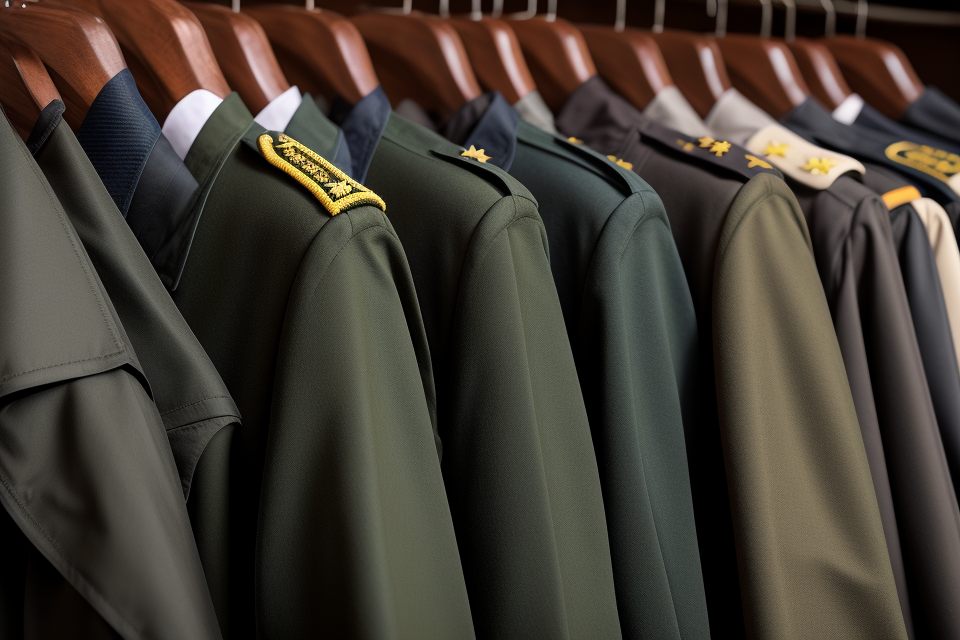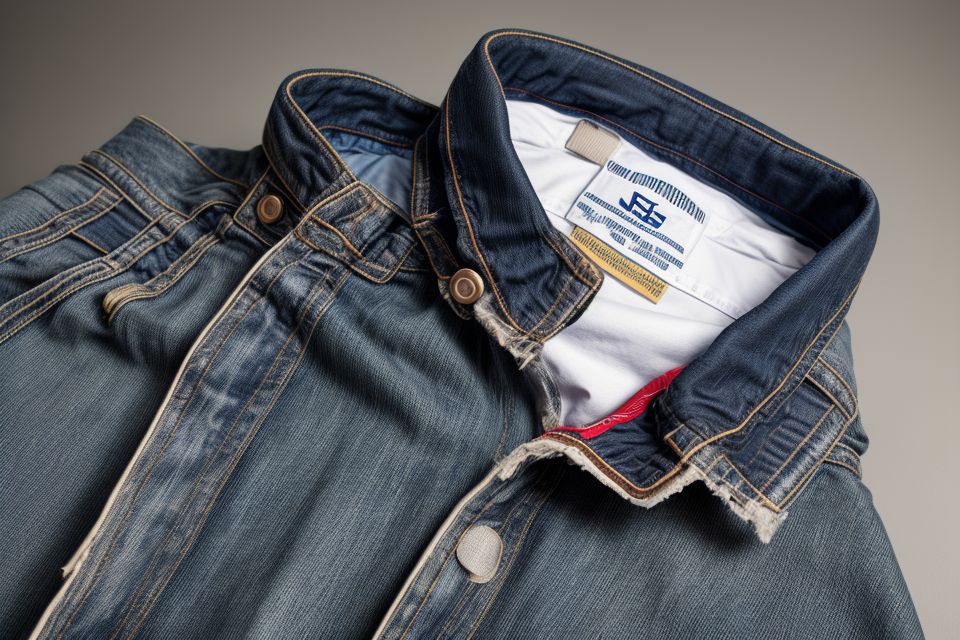
Uniforms are an essential part of our daily lives, especially for those who work in the service industry. But have you ever wondered how long your uniforms will last? The answer to this question can vary depending on several factors such as the type of fabric, the quality of the uniform, and how often it is worn and washed. In this article, we will explore the factors that affect the lifespan of uniforms and provide tips on how to prolong their life. So, whether you’re a chef, a nurse, or a delivery driver, read on to find out how long you can expect your uniforms to last.
The lifespan of your uniforms can vary depending on a number of factors such as the type of fabric, frequency of wear, care and maintenance, and environmental conditions. On average, you can expect your uniforms to last anywhere from several months to several years. Proper care and maintenance, such as washing and drying your uniforms correctly, can help extend their lifespan. Additionally, choosing high-quality materials and reputable brands can also impact the durability of your uniforms. Ultimately, the length of time your uniforms will last will depend on a combination of these factors.
Factors Affecting Uniform Durability
Fabric Type and Quality
Natural vs Synthetic Materials
The type of fabric used in creating uniforms plays a crucial role in determining their durability. Uniforms can be made from natural or synthetic materials, each with its own set of advantages and disadvantages.
- Natural Materials: Natural materials such as cotton, wool, and silk are often preferred for their softness and breathability. However, they tend to wear out faster than synthetic materials, especially when exposed to moisture or extreme temperatures.
- Synthetic Materials: Synthetic materials such as polyester, nylon, and spandex are known for their durability and resistance to moisture. They are also less prone to wrinkling and shrinking, making them ideal for uniforms that require a professional and neat appearance.
Durability of Different Fabrics
The durability of a fabric depends on various factors such as its thread count, weave, and finish. For instance, a fabric with a higher thread count is generally more durable than one with a lower thread count. Similarly, a fabric with a tight weave is less likely to fray or tear compared to one with a loose weave.
It is also important to consider the type of finish used on the fabric. For instance, a fabric with a water-repellent finish may last longer than one without such a finish when exposed to moisture.
In conclusion, the fabric type and quality play a crucial role in determining the durability of uniforms. While natural materials may be preferred for their softness and breathability, synthetic materials are often chosen for their durability and resistance to moisture. The specific type of fabric used will depend on the needs of the wearer and the environment in which the uniform will be used.
Frequency of Use
Frequency of use is a critical factor that determines how long your uniforms will last. The more often your uniforms are used, the faster they will wear out. In this section, we will explore the different aspects of frequency of use and how it affects the durability of your uniforms.
Regular Wear and Tear
Regular wear and tear are the most common reasons why uniforms wear out over time. When uniforms are worn frequently, they are exposed to daily wear and tear, which can cause them to become worn out and damaged. The more often your uniforms are worn, the more likely they are to sustain damage from regular wear and tear.
The most common type of damage caused by regular wear and tear is fading. This is because uniforms are exposed to light, heat, and moisture, which can cause the colors to fade over time. This type of damage is typically irreversible and can significantly affect the appearance of your uniforms.
Another common type of damage caused by regular wear and tear is wear and tear on the buttons, zippers, and other fasteners. These parts of the uniform are exposed to constant use and can become damaged or broken over time. This type of damage can be repaired, but it can be time-consuming and expensive.
Heavy Use and Damage
Heavy use and damage can also significantly affect the durability of your uniforms. When uniforms are used heavily, they are exposed to more wear and tear, which can cause them to become damaged more quickly. The most common type of damage caused by heavy use and damage is ripping and tearing.
This type of damage is typically caused by rough handling, such as when uniforms are stored in a bag or when they are being put on or taken off. It can also be caused by sharp objects, such as pens or keys, that may accidentally puncture the fabric.
Another type of damage caused by heavy use and damage is staining. This is because uniforms are exposed to a variety of substances, such as sweat, dirt, and grease, which can cause stains to form over time. This type of damage can be difficult to remove and may require professional cleaning.
In conclusion, the frequency of use is a critical factor that affects the durability of your uniforms. The more often your uniforms are used, the more likely they are to sustain damage from regular wear and tear and heavy use and damage. To ensure that your uniforms last as long as possible, it is essential to take proper care of them by following the recommended cleaning and maintenance procedures.
Maintenance and Care
Proper maintenance and care can significantly extend the lifespan of your uniforms. Neglecting these aspects can lead to premature wear and tear, which may cause the uniforms to become unusable after a short period. Here are some factors that influence the maintenance and care of your uniforms:
Cleaning Techniques
Cleaning your uniforms regularly is crucial to maintain their appearance and extend their lifespan. Different fabrics require different cleaning methods, so it’s essential to use the right method for each type of fabric. Here are some cleaning techniques for different types of fabrics:
- Polyester: Machine wash in cold water, tumble dry low, or dry clean. Avoid bleach, as it can weaken the fabric.
- Cotton: Machine wash in cold water, tumble dry low, or iron on the backside of the fabric. Avoid bleach, as it can weaken the fabric.
- Wool: Dry clean or hand wash in cold water. Avoid using bleach or detergents with bleach alternatives, as they can weaken the fabric.
- Silk: Hand wash in cold water with a mild detergent, or dry clean. Avoid using bleach or hot water, as they can damage the fabric.
Storage Conditions
Proper storage conditions can help protect your uniforms from damage and extend their lifespan. Here are some tips for storing your uniforms:
- Store your uniforms in a cool, dry place with good ventilation.
- Avoid storing your uniforms in direct sunlight or near heat sources, as this can cause color fading and shrinkage.
- Hang your uniforms on hangers or lay them flat, depending on the type of fabric.
- If you’re storing your uniforms for an extended period, consider using acid-free tissue paper or plastic bags to protect them from dust and moisture.
Repairs and Alterations
Minor repairs and alterations can help keep your uniforms in good condition and extend their lifespan. Here are some tips for repairing and altering your uniforms:
- For minor repairs, such as fixing a button or sewing on a patch, use a needle and thread or a sewing machine.
- For more significant repairs, such as replacing a zipper or repairing a tear, it’s best to take your uniform to a professional seamstress or alterations service.
- Avoid making alterations to your uniforms yourself, as this can damage the fabric or compromise the integrity of the garment.
In summary, proper maintenance and care are essential to extending the lifespan of your uniforms. Regular cleaning, proper storage conditions, and prompt repairs and alterations can help protect your uniforms from damage and ensure they remain in good condition for as long as possible.
Uniform Durability by Industry
Healthcare Uniforms
In the healthcare industry, uniforms are subjected to rigorous cleaning and sterilization processes, which can take a toll on their durability. The frequency of laundering, the type of detergents used, and the methods employed for sterilization can all impact the lifespan of healthcare uniforms.
Hospitality Uniforms
Uniforms in the hospitality industry, such as those worn by hotel staff or restaurant servers, are often exposed to a high degree of wear and tear. These uniforms may be laundered on a regular basis, and may be subjected to stains, spills, and other forms of damage. The type of fabric used in the uniforms, as well as the care instructions provided by the manufacturer, can play a significant role in determining their longevity.
Corporate Uniforms
Corporate uniforms, such as those worn by customer service representatives or sales staff, may be subjected to a range of environmental factors that can impact their durability. For example, uniforms worn by employees who work outdoors may be exposed to rain, sun, and wind, which can cause fading, discoloration, and other forms of damage. The type of fabric used in the uniforms, as well as the level of care provided by the wearer, can impact their lifespan.
Service Uniforms
Service uniforms, such as those worn by police officers, firefighters, or military personnel, are designed to withstand a high degree of wear and tear. These uniforms may be subjected to a range of environmental factors, including extreme temperatures, moisture, and exposure to chemicals. The type of fabric used in the uniforms, as well as the level of care provided by the wearer, can impact their longevity.
Determining Uniform Lifespan
Visual Inspection
Visual inspection is a crucial step in determining the lifespan of your uniforms. It involves examining the uniforms for common signs of wear and tear, which can help you identify when it’s time to replace them. Here are some key points to consider when conducting a visual inspection of your uniforms:
- Common Signs of Wear and Tear: Some common signs of wear and tear that indicate it’s time to replace your uniforms include fading, discoloration, holes, and fraying. These signs can impact the appearance and functionality of the uniforms, and may also compromise safety.
- Identifying Reusable Components: Visual inspection can also help you identify reusable components of your uniforms, such as buttons, zippers, and insignia. These components can often be replaced or restored, extending the lifespan of the uniforms and reducing waste.
- Checking for Damage: In addition to looking for common signs of wear and tear, it’s important to check your uniforms for any unusual or unexpected damage. This could include tears, stains, or other signs of damage that may impact the functionality or safety of the uniforms.
- Scheduling Regular Inspections: To ensure that your uniforms last as long as possible, it’s important to schedule regular inspections. This can help you identify any issues early on and take action to address them before they become more serious. Regular inspections can also help you determine when it’s time to replace your uniforms, based on their overall condition and any signs of wear and tear.
Uniform Lifespan Calculation
Calculating the lifespan of your uniforms can be a useful exercise in determining how often you will need to replace them. There are several factors to consider when determining the lifespan of your uniforms, including the type of uniform, the frequency of wear, and the level of care and maintenance.
Basic Lifespan Formula
One way to calculate the lifespan of your uniforms is to use a basic formula that takes into account the number of wears per year and the expected lifespan of the uniform in years. For example, if you wear your uniform once a week and it has an expected lifespan of 5 years, you can expect your uniform to last for approximately 260 wears.
Factors to Consider
While the basic formula can provide a rough estimate of the lifespan of your uniforms, there are several other factors that you should consider when determining how long your uniforms will last. These factors include:
- Type of uniform: Different types of uniforms, such as those made from different fabrics or with different features, may have different lifespans.
- Frequency of wear: Uniforms that are worn more frequently may wear out faster than those that are worn less often.
- Level of care and maintenance: Uniforms that are properly cared for and maintained may last longer than those that are not.
- Environmental factors: Uniforms that are exposed to harsh environmental conditions, such as high temperatures or moisture, may wear out faster than those that are not.
By taking these factors into account, you can get a more accurate estimate of how long you can expect your uniforms to last.
Maximizing Uniform Lifespan
Proper Care and Maintenance
Proper care and maintenance are essential for extending the lifespan of your uniforms. Regular cleaning, storing uniforms properly, and timely repairs and alterations are crucial to ensuring that your uniforms remain in good condition for as long as possible.
Regular Cleaning
Regular cleaning is vital to maintain the hygiene and appearance of your uniforms. Dirt, stains, and odors can accumulate over time, which can not only make your uniforms look unkempt but also lead to the growth of bacteria and other microorganisms. Therefore, it is important to clean your uniforms regularly, depending on the frequency of wear and the type of fabric they are made of.
When cleaning your uniforms, it is recommended to use a mild detergent or laundry soap, as harsh chemicals can damage the fabric and reduce its lifespan. Additionally, avoid using chlorine bleach on protein-based stains such as blood, as it can cause them to yellow. Instead, use a bleach alternative or soak the uniform in cold water with a tablespoon of salt.
Storing Uniforms Properly
Proper storage of your uniforms is essential to prevent damage and extend their lifespan. Improper storage can cause wrinkles, creases, and even discoloration, which can affect the overall appearance of your uniforms. Therefore, it is important to store your uniforms in a clean, dry, and well-ventilated area, away from direct sunlight and moisture.
When storing your uniforms, it is recommended to hang them up or fold them properly, avoiding excessive stacking or bundling. Additionally, consider using garment bags or covers to protect your uniforms from dust, dirt, and other particles. This can help to keep your uniforms looking newer for longer.
Timely Repairs and Alterations
Timely repairs and alterations are necessary to maintain the functionality and appearance of your uniforms. Wear and tear, rips, and tears can occur over time, which can affect the performance and safety of your uniforms. Therefore, it is important to identify and address these issues promptly to prevent further damage.
When repairing or altering your uniforms, it is recommended to seek professional assistance from a qualified seamstress or tailor. This can help to ensure that the repairs and alterations are done correctly and efficiently, and that your uniforms remain in good condition for as long as possible. Additionally, avoid delaying repairs or alterations, as this can lead to more significant damage and affect the overall lifespan of your uniforms.
Rotating Uniforms
One effective strategy for extending the lifespan of your uniforms is rotating them regularly. This approach ensures that each piece of clothing is given adequate rest, reducing wear and tear, and extending its useful life.
Creating a Schedule
Creating a schedule for rotating your uniforms is crucial for maximizing their lifespan. It involves assigning specific days or shifts for each uniform, ensuring that no piece is worn more frequently than necessary. By doing so, you can distribute the wear and tear evenly across all the uniforms, allowing each one to last longer.
To create an effective rotation schedule, consider the following steps:
- Assign a unique identifier to each uniform (e.g., 1, 2, 3, etc.).
- Determine the number of uniforms needed and how many days or shifts each will be worn.
- Develop a spreadsheet or use a dedicated software to track the rotation schedule.
- Communicate the schedule to your team members and ensure they adhere to it.
Alternating Uniforms
Alternating uniforms involves assigning each piece of clothing to a specific position or role, ensuring that they are not worn simultaneously. This method helps in reducing the wear and tear on each uniform, leading to a longer lifespan.
For example, you could assign one uniform to be worn during day shifts and another for night shifts. By doing so, each uniform is only exposed to the specific conditions and activities associated with its designated shift, minimizing the potential for damage.
In addition, alternating uniforms can also help in identifying any potential issues with the clothing. If a particular uniform consistently shows signs of wear and tear or damage, it may be an indication that it’s time to retire that piece and replace it with a new one.
In conclusion, rotating and alternating uniforms are effective strategies for extending their lifespan. By creating a schedule and assigning specific roles to each uniform, you can ensure that they are worn and cared for in a way that maximizes their useful life, while also minimizing the need for frequent replacements.
Extending Uniform Life
Repurposing Uniform Components
When it comes to extending the life of your uniforms, repurposing uniform components is an effective strategy. By repurposing uniform components, you can prolong the life of your uniforms and reduce waste. Here are some ways to repurpose uniform components:
Adapting for Different Roles
One way to repurpose uniform components is by adapting them for different roles. For example, if you have a jacket that is no longer suitable for its original purpose, you can repurpose it as a vest or a work jacket. This way, you can prolong the life of the jacket and give it a new purpose.
Replacing Individual Parts
Another way to repurpose uniform components is by replacing individual parts. For instance, if your pants have become too short or too tight, you can replace the pants legs or the waistband. This way, you can prolong the life of your pants and give them a new lease of life.
In conclusion, repurposing uniform components is a great way to extend the life of your uniforms. By adapting components for different roles or replacing individual parts, you can prolong the life of your uniforms and reduce waste.
Upcycling Uniforms
-
Repurposing Uniforms
- Customization
- Adding embroidery or patches
- Altering the fit
- Repurposing Materials
- Making uniform accessories
- Crafting other clothing items
- Customization
-
Reusing Uniforms
- Donating to charity or community organizations
- Reselling or trading with other organizations
- Offering to employees as incentives or rewards
By upcycling uniforms, you can extend their life and reduce waste. Customization and repurposing materials are two effective ways to achieve this goal. Adding embroidery or patches, altering the fit, and making uniform accessories are examples of customization. Repurposing materials by making uniform accessories or crafting other clothing items can also extend the life of uniforms.
Reusing uniforms is another way to extend their life. Donating to charity or community organizations, reselling or trading with other organizations, and offering to employees as incentives or rewards are all options for reusing uniforms. These practices not only help reduce waste but also provide value to the organization and its employees.
Key Takeaways
- Understanding the factors that affect uniform durability is crucial in determining the lifespan of your uniforms.
- Uniform lifespan can be maximized by proper care and maintenance, including regular cleaning, stain removal, and storage.
- Extending the life of your uniforms not only saves money but also reduces the environmental impact of uniform production and disposal.
Factors Affecting Uniform Durability
- Uniform durability is influenced by several factors, including the type of fabric, the quality of construction, and the level of wear and tear.
- Uniforms made from high-quality materials and constructed with durable stitching will generally last longer than those made from lower-quality materials.
- The level of wear and tear can also impact the lifespan of uniforms, with uniforms that are subjected to heavy use or harsh environments wearing out more quickly.
Determining Uniform Lifespan
- To determine the lifespan of your uniforms, consider the type of fabric, the quality of construction, and the level of wear and tear.
- Look for signs of wear and tear, such as fading, stains, and loose threads, which can indicate that it’s time to replace your uniforms.
- It’s important to regularly inspect your uniforms to ensure they are still in good condition and safe to wear.
Maximizing Uniform Lifespan
- Proper care and maintenance can help maximize the lifespan of your uniforms.
- Regular cleaning, including stain removal and spot cleaning, can help keep your uniforms looking and feeling fresh.
- Proper storage, including hanging or folding uniforms correctly, can help prevent damage and extend their lifespan.
Extending Uniform Life
- There are several ways to extend the life of your uniforms, including:
- Regular cleaning and stain removal to prevent damage
- Proper storage to prevent damage and reduce wear and tear
- Repairing small damages, such as loose buttons or missing stitches, to prevent further damage
- Using protective gear, such as gloves or aprons, to prevent damage from spills or stains
Conclusion
- By understanding the factors that affect uniform durability and taking proper care of your uniforms, you can extend their lifespan and reduce the need for frequent replacements.
- This not only saves money but also reduces the environmental impact of uniform production and disposal.
FAQs
1. How long do uniforms typically last?
Uniforms can last anywhere from a few months to several years, depending on factors such as the quality of the materials, the level of care they receive, and the frequency of wear. In general, well-made uniforms can last up to two years or more with proper care.
2. What factors can affect the lifespan of uniforms?
Several factors can affect the lifespan of uniforms, including the quality of the materials, the level of care they receive, and the frequency of wear. Uniforms made from high-quality materials and constructed with durability in mind can last longer than those made from lower-quality materials. In addition, proper care and maintenance, such as washing and drying according to the label instructions, can help extend the lifespan of uniforms.
3. How can I extend the lifespan of my uniforms?
To extend the lifespan of your uniforms, it’s important to follow proper care and maintenance instructions. This includes washing and drying your uniforms according to the label instructions, avoiding bleach or other harsh chemicals, and storing them in a cool, dry place when not in use. Additionally, regularly inspecting your uniforms for signs of wear and tear can help you identify when it’s time to replace them.
4. What are the signs that my uniforms need to be replaced?
There are several signs that your uniforms may need to be replaced, including fading or discoloration, wear and tear, and damage to the materials. Additionally, if your uniforms no longer fit properly or are not meeting the required standards, it may be time to replace them. It’s important to replace uniforms in a timely manner to ensure they continue to meet the required standards and maintain a professional appearance.


